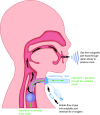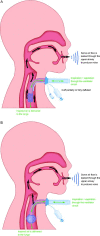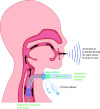A Multidisciplinary Approach to Verbal Communication Interventions for Mechanically Ventilated Adults With a Tracheostomy
- PMID: 37076435
- PMCID: PMC10171346
- DOI: 10.4187/respcare.10511
A Multidisciplinary Approach to Verbal Communication Interventions for Mechanically Ventilated Adults With a Tracheostomy
Abstract
There is developing evidence with regard to the feasibility, utility, and safety of verbal communication interventions with patients with tracheostomy who are invasively ventilated. In the past 2 decades, research efforts have focused on establishing evidence for communication interventions, including introducing an intentional leak into the ventilatory circuit such as with a fenestrated tube, leak speech or ventilator-adjusted leak speech, the use of a one-way valve in-line with the ventilator, and above cuff vocalization. This narrative review describes the benefits of a multi-disciplinary approach, summarizes verbal communication interventions, and provides guidance on the indications, contraindications and considerations for patient selection. Our clinical procedures based on collective clinical experience are shared. A multidisciplinary team approach enables holistic management across acuity, ventilation, airway, communication, and swallowing parameters. This collaborative approach is recommended to maximize the chance of successful opportunities for patients to communicate safely and effectively.
Keywords: clinical procedures; communication; multidisciplinary; speech; tracheostomy; ventilation; voice.
Copyright © 2023 by Daedalus Enterprises.
Conflict of interest statement
The authors have disclosed no conflicts of interest.
Figures
Similar articles
-
The use of tracheostomy speaking valves in mechanically ventilated patients results in improved communication and does not prolong ventilation time in cardiothoracic intensive care unit patients.J Crit Care. 2015 Jun;30(3):491-4. doi: 10.1016/j.jcrc.2014.12.017. Epub 2015 Jan 6. J Crit Care. 2015. PMID: 25599947
-
The Feasibility, Utility, and Safety of Communication Interventions With Mechanically Ventilated Intensive Care Unit Patients: A Systematic Review.Am J Speech Lang Pathol. 2019 Aug 9;28(3):1335-1355. doi: 10.1044/2019_AJSLP-19-0001. Epub 2019 Jul 11. Am J Speech Lang Pathol. 2019. PMID: 31296037
-
Verbal communication of ventilator-dependent patients.Crit Care Med. 1993 Apr;21(4):512-7. doi: 10.1097/00003246-199304000-00009. Crit Care Med. 1993. PMID: 8472569
-
Speaking valves in tracheostomised ICU patients weaning off mechanical ventilation--do they facilitate lung recruitment?Crit Care. 2016 Apr 1;20:91. doi: 10.1186/s13054-016-1249-x. Crit Care. 2016. PMID: 27038617 Free PMC article.
-
Facilitating speech in the patient with a tracheostomy.Respir Care. 2005 Apr;50(4):519-25. Respir Care. 2005. PMID: 15807915 Review.
Cited by
-
Enhancing Communication in Critically Ill Patients with a Tracheostomy: A Systematic Review of Evidence-Based Interventions and Outcomes.Tracheostomy. 2024;1(1):26-41. doi: 10.62905/001c.115440. Epub 2024 Mar 31. Tracheostomy. 2024. PMID: 39253605 Free PMC article.
References
-
- Hafsteindottir T. Patient's experiences of communication during the respirator treatment period. Intensive Crit Care Nurs 1996;12(5):261–271. - PubMed
-
- Zengin N, Oren B, Ustundag H. The relationship between stressors and intensive care unit experiences. Nurs Crit Care 2020;25(2):109–116. - PubMed
-
- Tembo A, Higgins I, Parker V. The experience of communication difficulties in critically ill patients in and beyond intensive care: findings from a larger phenomenological study. Intensive Crit Care Nurs 2015;31(3):171–178. - PubMed
-
- Manzano J, Lubillo S, Henriquez D, Martin J, Perez M, Wilson DJ. Verbal communication of ventilator-dependent patients. Crit Care Med 1993;21(4):512–517. - PubMed
-
- Heffner JE. Management of the chronically ventilated patient with a tracheostomy. Chron Respir Dis 2005;2(3):151–161. - PubMed
Publication types
MeSH terms
LinkOut - more resources
Full Text Sources
Miscellaneous





